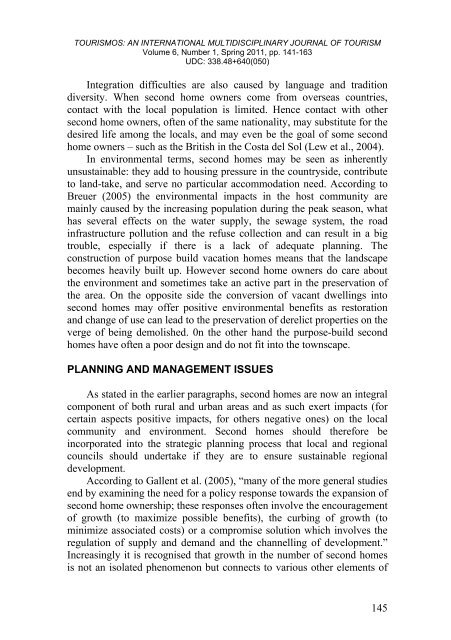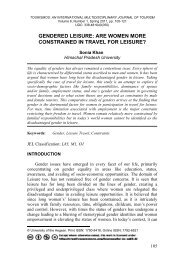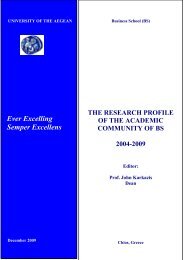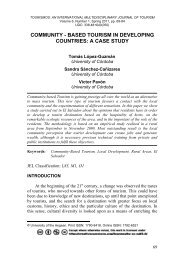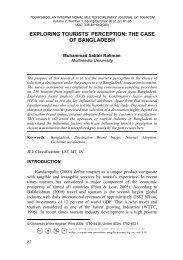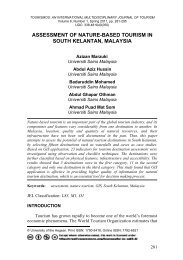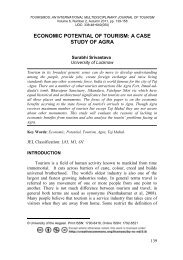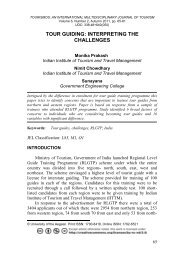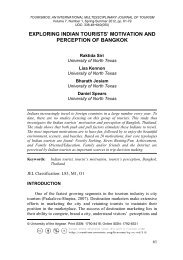TOURISMOS is an international, multi-disciplinary, refereed (peer ...
TOURISMOS is an international, multi-disciplinary, refereed (peer ...
TOURISMOS is an international, multi-disciplinary, refereed (peer ...
Create successful ePaper yourself
Turn your PDF publications into a flip-book with our unique Google optimized e-Paper software.
<strong>TOURISMOS</strong>: AN INTERNATIONAL MULTIDISCIPLINARY JOURNAL OF TOURISM<br />
Volume 6, Number 1, Spring 2011, pp. 141-163<br />
UDC: 338.48+640(050)<br />
Integration difficulties are also caused by l<strong>an</strong>guage <strong>an</strong>d tradition<br />
diversity. When second home owners come from overseas countries,<br />
contact with the local population <strong>is</strong> limited. Hence contact with other<br />
second home owners, often of the same nationality, may substitute for the<br />
desired life among the locals, <strong>an</strong>d may even be the goal of some second<br />
home owners – such as the Brit<strong>is</strong>h in the Costa del Sol (Lew et al., 2004).<br />
In environmental terms, second homes may be seen as inherently<br />
unsustainable: they add to housing pressure in the countryside, contribute<br />
to l<strong>an</strong>d-take, <strong>an</strong>d serve no particular accommodation need. According to<br />
Breuer (2005) the environmental impacts in the host community are<br />
mainly caused by the increasing population during the peak season, what<br />
has several effects on the water supply, the sewage system, the road<br />
infrastructure pollution <strong>an</strong>d the refuse collection <strong>an</strong>d c<strong>an</strong> result in a big<br />
trouble, especially if there <strong>is</strong> a lack of adequate pl<strong>an</strong>ning. The<br />
construction of purpose build vacation homes me<strong>an</strong>s that the l<strong>an</strong>dscape<br />
becomes heavily built up. However second home owners do care about<br />
the environment <strong>an</strong>d sometimes take <strong>an</strong> active part in the preservation of<br />
the area. On the opposite side the conversion of vac<strong>an</strong>t dwellings into<br />
second homes may offer positive environmental benefits as restoration<br />
<strong>an</strong>d ch<strong>an</strong>ge of use c<strong>an</strong> lead to the preservation of derelict properties on the<br />
verge of being demol<strong>is</strong>hed. 0n the other h<strong>an</strong>d the purpose-build second<br />
homes have often a poor design <strong>an</strong>d do not fit into the townscape.<br />
PLANNING AND MANAGEMENT ISSUES<br />
As stated in the earlier paragraphs, second homes are now <strong>an</strong> integral<br />
component of both rural <strong>an</strong>d urb<strong>an</strong> areas <strong>an</strong>d as such exert impacts (for<br />
certain aspects positive impacts, for others negative ones) on the local<br />
community <strong>an</strong>d environment. Second homes should therefore be<br />
incorporated into the strategic pl<strong>an</strong>ning process that local <strong>an</strong>d regional<br />
councils should undertake if they are to ensure sustainable regional<br />
development.<br />
According to Gallent et al. (2005), “m<strong>an</strong>y of the more general studies<br />
end by examining the need for a policy response towards the exp<strong>an</strong>sion of<br />
second home ownership; these responses often involve the encouragement<br />
of growth (to maximize possible benefits), the curbing of growth (to<br />
minimize associated costs) or a comprom<strong>is</strong>e solution which involves the<br />
regulation of supply <strong>an</strong>d dem<strong>an</strong>d <strong>an</strong>d the ch<strong>an</strong>nelling of development.”<br />
Increasingly it <strong>is</strong> recogn<strong>is</strong>ed that growth in the number of second homes<br />
<strong>is</strong> not <strong>an</strong> <strong>is</strong>olated phenomenon but connects to various other elements of<br />
145


